Abstract
The adoption of comics in education has also been a subject of great interest among the scientific community where an abundance of research has been conducted on the cognitive and affective effects of comics. However, few of these studies aimed at extending our understanding towards learners’ perception, interest, and prior knowledge of educational comics. Therefore, this working paper discusses students’ motivation, obstacles, and requirements for the implementation and design of learner-generated comics. The findings of this study contribute to the literature by providing useful information for educators and instructional designers in formulating strategies for unlocking the potential of learner-generated comics within classroom environment.
Keywords: Comicslearner-generated contenteducational mediastudent-centred learning
Introduction
The term “Educational Comic” is defined as “a form of cartoons in which a cast of characters present an educational story in a sequence of closely related drawings designed to entertain and educate the reader” (Alaba., 2007). These visual media are specifically designed to extend students’ erudition and foster engagement beyond the confines of the classroom. Hence, the advantage of comics should not be dismissed as students expand comprehension, meaning from the lively illustrations or the interplay among panels, avoiding them from depending to solely on text-based reading strategies (Jennings, Rule, & Zanden, 2014).
Learner-generated comic projects are a comic-based activity where learners themselves craft personalized comics in order to reach a pedagogical aim. This activity operates as a supplementary method for students to absorb difficult academic topics (Engler, Hoskins, & Payne, 2008) and polish their research skills (Morrison, Bryan, & Chilcoat, 2002). Aside from illustrating graphic novels with traditional materials recent classroom practice begins to interactively utilize digital authoring systems for LGC involving photo-based and pre-made item-based comic development tools (Farah, Syamsul, & Norshuhada, 2014).
Since an ideal comic research should consider users’ familiarity with this medium (Caldwell, 2012), this paper discusses students’ perception, motivation, obstacles, and requirements for the implementation and design of educational comics. This is done by acquiring and analysing respondents’ general feedback from a survey.
Methodology
The study used questionnaire as the instrument for data collection. The study lasted for three days before analysis on collected data was performed. The respondents (students whose age ranging from 20 to 26 years) were randomly selected from UUM (Universiti Utara Malaysia) community. In order to assist their understanding on the topic of the questionnaire, an A2 sized poster of a comic (Fig. 1) was presented. The comic exposed students to examples and benefits of educational comics.
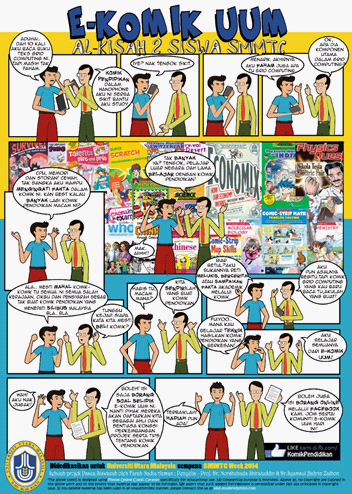
The questions were addressed to investigate the following aspects: (1) respondents’ background related to reading comics and their supporting technology (2) respondents’ perceptions towards comics as an instructional tool (3) respondents’ expectations and drawbacks of learner-generated comics (4) indication of digital tools that respondents feel are promising for learner-generated comics development. A few basic demographic questions were included in the questionnaire. Finally, basic statistical method was used to assess the student responses which particularly using descriptive techniques as presented in the next section.
Findings and Results
Comic Reading Behaviour
In the first questionnaire item, the respondents were asked about how frequently they read comics in weekly basis. As depicted in Fig 2, nearly 60% of the students read printed comics once or more, while the rest rarely or almost never read comics. The frequency rate also shows that 70% of the respondents used social media to read online comics.
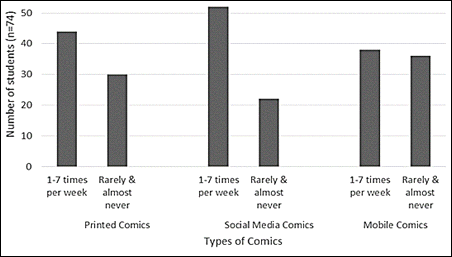
Contrariwise, half of the participants downloaded comics from mobile app stores while the other partial did not. These statistics revealed that there was a balance between the respondents’ preferences towards printed and digital comics. Plus, it is also indicated that comics are a common and non-isolated media among more than half of the students.
Second question asks why students read comics (see Fig 3) where the questionnaire comprises of a 5-point Likert scales, 5-strongly agree, 4-agree, 3- slightly agree, 2- disagree, 1-strongly disagree. More than half of them agreed that comics are a fun leisure (55%) and able to reduce stress (51%). 28% of the respondents strongly agreed, and only one student disagreed with the both mentioned statements. Aside from that, the overall percentage reported that the majority of students (73%) preferred comics because their message is effectively presented with less text and sequenced visuals.
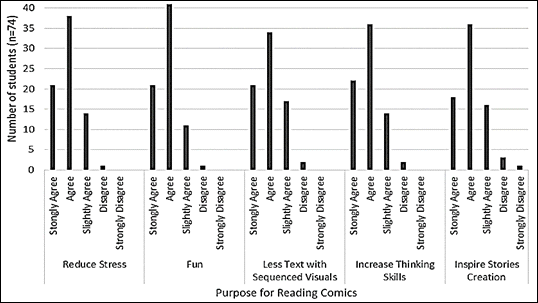
Furthermore, students also agreed that comics helped them boost their mind and thinking skills (49%). About 30% and 19% of the respondents strongly and slightly agreed, plus only 2 students disagreed with the previous statement. Literally, students also stated their opinion whether comics inspire them to create their own stories in other forms such as novels or movie scripts. Overall, 95% of respondents found comics are useful for the mentioned purpose while only 5% did not in contrast. Based on the statistics, it could be concluded that comics are an easy and visually entertaining reading material which also amplify students’ thinking and storytelling skills.
Afterwards, when the students were questioned about the potential of educational comics, they were first asked if they have read educational comics previously. Amusingly, nearly 80% of the respondents admitted that they have past experience reading them. Students were then given several questions in order to acquire their outlook on benefits of educational comics (see Fig 4).
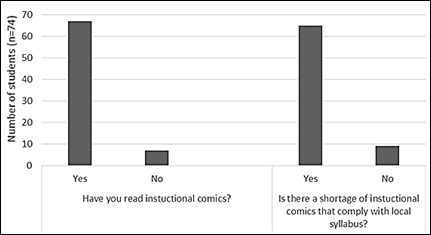
The overall results exposed that majority of the students (97%) had come into a general agreement that that educational comics are able to teach moral and spiritual values (see
Despite these affirmative views however, 88% of the respondents agreed that there is a shortage of educational comics that comply with Malaysian school syllabus as shown in Figure
Views towards Learner-Generated Comic
Next, students were given several questions in order to acquire their perception towards LGC (Table
As seen in Fig 5, most of the students (85%) stated that they were interested in developing LGC to assist their learning (Q1) while the rest did not. 88% of the respondents agreed with Q2, Q3, and Q5, concluding that the educational comics they developed should fit the learners’ own personal taste, represents the local image and identity, and contain more academic content than the story. However, a slightly higher percentage was achieved in Q4 where 90% of the students favoured a balance between academic content and story in their personalized educational comics.
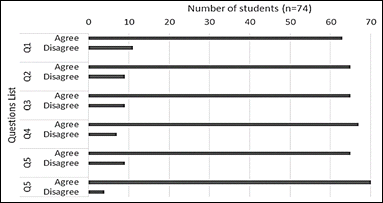
Inclusively, a vast majority of the respondents (95%) agreed with Q6 which displayed their hope that the educational comics created by them could be utilized as an educational resource for other students to a certain extent. These statistics described that, students not only showed high interest in LGC, but they also have certain criteria towards their creations, so that the educational comics could be a useful means for other learners besides themselves.
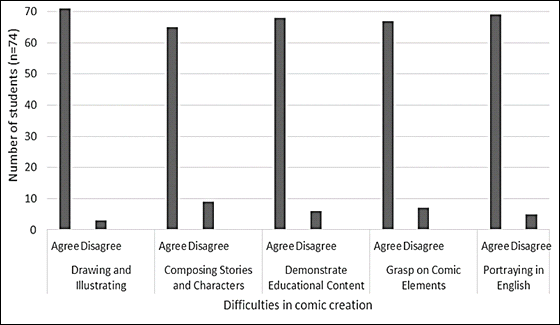
In addition, the survey also enquires students problems in LGC (see Fig 5). Respondents were asked the difficulties they expected to confront while designing their own educational comic. The highest percentage exposed that the drawing and illustrating (96%) is the hardest tasks in educational comic development. Second, 93% of the students claimed their limited command in English to tell their story. Closer to the second difficulty, 92% of the respondents disclosed their lack of expertise in demonstrating educational content.
Next, about 90% of them had limited knowledge in elements of a well-crafted comics. Lastly, 87% of the respondents agreed that composing stories and characters are also a challenge in educational comic development. Based on the result, it could be determined that majority of the students required a comprehensive guideline correspond to different aspects in order to lessen their difficulties in designing an educational comic.
Finally, the survey asks students’ grasp in authoring tools that enable comic creation (see Figure 8). 74% of the respondents asserted that they have past experience using standalone graphic editing tools such as Photoshop, Illustrator or

Conclusion
The study measures the perception of students on comics as an educational tool. The statistics revealed that there was a balance between respondents’ preferences towards printed and digital comics. Comics are an easy and visually entertaining reading material which also amplifies students’ thinking and storytelling skills. Meanwhile, students do not only showed high interest in learner-generated comics (LGC), but they also have certain criteria towards their personalized comics, so that their creations could be a useful means for other learners besides themselves. These criteria include LGC should fit the learners’ own personal taste, represents the local image and identity, and contain more academic content compared to story elements.
The overall findings appear to support that educational comics are a helpful medium to enhance learning experience. Principally, this preliminary study concludes that there is a huge potential in implementing LGC projects in formal classroom environment. On the other hand, the majority of the respondents required more insight into different aspects educational comic development. Therefore, future research should emphasize the design of a comprehensive pedagogical guideline to improve strategies for LGC implementation.
Acknowledgements
The authors would like to thank the Center of Teaching and Learning (UTLC), Universiti Utara Malaysia for funding this research.
References
- Alaba, S. O. (2007). The Use of Educational Cartoons and Comics in Enhancing Creativity in Primary School Pupils. Journal of Applied Sciences Research, 3(10), 913–920.
- Botzakis, Stergios. (2013). Visual and Digital Texts. Journal of Adolescent & Adult Literacy 57 (September): 72–74.
- Bower, Matt, John G. Hedberg, and Andreas Kuswara. (2010). A Framework for Web 2.0 Learning Design.” Educational Media International 47 (3), 177–98.
- Engler, S., Hoskins, C., & Payne, S. (2008). Computer-Produced Comics as a Means of Summarising Academic Readings in EAP Programs. International Journal of Pedagogies and Learning, 4(4), 19–33.
- Farah, N. A., Syamsul, B. Z., & Norshuhada, S. (2014). Exploring Digital Comics as an Edutainment Tool : An Overview. In Knowledge Management International Conference 2014 (pp. 589–594).
- Jennings, K. A., Rule, A. C., & Zanden, S. M. Vander. (2014). Fifth Graders ’ Enjoyment , Interest , and Comprehension of Graphic Novels Compared to Heavily-Illustrated and Traditional Novels. International Electronic Journal of Elementary Education, 6(2), 257–274.
- Mallia, Gorg. 2007. Learning from the Sequence: The Use of Comics in Instruction. ImageTexT: Interdisciplinary Comics Studies 3 (3), 1–10.
- Melor, Md Yunus, Salehi Hadi, and Embi Mohamed Amin. (2012). Effects of Using Digital Comics to Improve ESL Writing. Research Journal of Applied Sciences, Engineering and Technology 4 (18): 3462–69.
- Morrison, T. G., Bryan, G., & Chilcoat, G. W. (2002). Using student generated comics in the classroom. Journal of Adolescent & Adult Literacy, 45(8), 758–767.
- Recine, David. 2013. Comics Aren ’ T Just For Fun Anymore : The Practical Use of Comics by TESOL Professionals. University of Wisconsin-River Falls.
- Yıldırım, Aşkın H. (2013). Using Graphic Novels in the Classroom. Journal of Language and Literature Education, 8, 118–31.
Copyright information

This work is licensed under a Creative Commons Attribution-NonCommercial-NoDerivatives 4.0 International License.
About this article
Publication Date
22 August 2016
Article Doi
eBook ISBN
978-1-80296-013-6
Publisher
Future Academy
Volume
14
Print ISBN (optional)
-
Edition Number
1st Edition
Pages
1-883
Subjects
Sociology, work, labour, organizational theory, organizational behaviour, social impact, environmental issues
Cite this article as:
Azman, F. N., Zaibon, S. B., & Shiratuddin, N. (2016). User’s Perception on Learner-Generated Comics: A Preliminary Study. In B. Mohamad (Ed.), Challenge of Ensuring Research Rigor in Soft Sciences, vol 14. European Proceedings of Social and Behavioural Sciences (pp. 643-650). Future Academy. https://doi.org/10.15405/epsbs.2016.08.91

